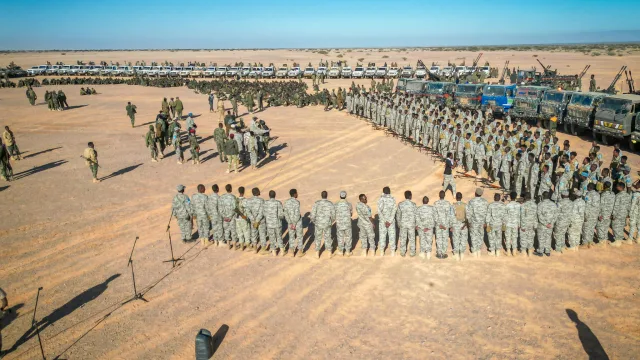The growth of piracy off the coast of Somalia from an occasional nuisance to shipping into…
The growth of piracy off the coast of Somalia from an occasional nuisance to shipping into a multi-million-dollar criminal enterprise has another, often deliberately overlooked cost: the worsening violence meted out to thousands of captured crew members.
“There definitely has been a change, and we don’t know why,” Pottengal Mukundan, Director of the International Maritime Bureau (IMB), told a June meeting on the subject in London.
“It may be to do with the fact that there is now a different kind of people looking after the captives. These are just gangs of thugs; they have never been to sea and they have no empathy with the seafarers,” said Mukundan.
Statistics from 2010 (taken from The Human Cost of Somali Piracy, unless otherwise indicated) illustrate the scale of piracy’s expansion in the western Indian Ocean and Gulf of Aden:
•4,000-plus seafarers attacked with firearms, including rocket propelled grenades
•400 piracy attacks, according to the UN Office on Drugs and Crime (UNODC)
•1,016 crew members taken hostage (up from a worldwide 188 in 2006 – IMB)
•Over 400 hostages were used as human shields
•five months was the average duration of captivity
•US$111m paid in ransoms (UNODC report: The illicit financial flows linked to piracy off the coast of Somalia)
Until recently, Somali pirates were known for treating their captives well. But now, according to The Human Cost of Somali Piracy, a report published this month by Oceans Beyond Piracy, hostages are severely beaten, dragged underwater, have had wires tightened round their genitals, and have undergone elaborate mock executions.
“Both successful and unsuccessful attacks expose seafarers to dangerous experiences, with the potential for long-term physical and psychological trauma,” said the report.
Crew members who seek refuge in a “citadel”, or safe room, might spend several terrifying days locked in a confined space while attackers fire heavy weapons at the door, light fires under the ventilators, or even use welding equipment to try to break through the walls.
After the initial distress of being chased and shot at during an attack, hostages endure beatings, confinement and torture at the hands of their captors.
“We have found strong evidence that over a third of the seafarers that were held in 2010 were abused, and the trend is looking more ominous this year,” said Kaija Hurlburt, who wrote the report.
Psychological pressure
The seafarers themselves are not the only ones to suffer. To put more pressure on shipping companies to pay up quickly, pirates sometimes called families and threatened to kill their loved ones if ransom was not delivered soon. “There have been cases where the hostage has been forced to call his family, and is beaten while his family listens on the phone,” said Hurlburt, who added that both hostages and families are kept in the dark during negotiations. “It is clear that seafarers and their families suffer stress at every point along the way, from the moment their ship enters pirate-infested waters,” she said.
“The risks encountered in the course of their work would be unacceptable in most industries,” the report said.
With more than 3,000 seafarers taken hostage by Somali pirates since 2008 and hundreds currently in captivity, the situation was a “humanitarian crisis”, according to International Chamber of Shipping (ICS) spokesman Simon Bennett. “The crisis really has spiralled out of control.”
The pirates are also using new tactics such as turning hijacked boats into “motherships” from which to launch more attacks in which captive crew members are forced to take part.
No longer restrained by the size of their boats or their sailing capabilities, these pirates are limited only by the amount of fuel they can get. Somali pirates are now carrying out attacks over 1,000 nautical miles away from Somalia.
Shipping companies are often silent about what happens to hostage crews, said Andrew Palmer of Idarat Maritime, which advises shipowners and the burgeoning shipping insurance industry. Palmer told IRIN companies made their employees sign confidentiality agreements promising not to talk about their experiences at sea. Disclosure was not in the companies’ interests, he said, because of the risk of mutiny.
While some seafarers now refuse to sail in waters off Somalia, others feel they have no choice, “because their families, and in some cases entire villages, rely on their incomes,” Hurlburt said in her report.
The industry has been forced to respond to the crisis given what Bennett called “horrible frustration and despair” at the new developments in hostage treatment.
But the increasing tendency to employ armed security guards aboard ships has its drawbacks, according to Wing Commander Paddy O’Kennedy, spokesman for the European Union Naval Force Somalia.
“If someone who’s particularly good at a war game on the X-box decides he’d be good in a security company you’re going to get cowboys out there,” he said, noting that some security teams had fired on fishermen they had mistaken for pirates.
In 2009, several countries with coastlines on the pirate-infested waters adopted a code of conduct to tackle piracy which committed them to facilitate “proper care, treatment, and repatriation for seafarers, fishermen, other shipboard personnel and passengers subject to piracy or armed robbery against ships, particularly those who have been subjected to violence.”
“Wrong nationality”
But, according to UNODC spokesman Wayne Miller, signatories have not lived up to this obligation, on the grounds that the affected hostages came from non-signatory states.
“The majority of the seafarers have got the wrong nationality,” said ICS spokesman Bennett. “Most of the crews held hostage have been Filipino and Indian, not American and European. As a consequence, it doesn’t quite generate the same media interest,” or incentive for military intervention.
“At a time when both financial and military resources are extremely stretched, Western governments, at least, appear to have concluded that this unacceptable situation can somehow be tolerated,” wrote the ICS in its “Key Issues of 2011” statement.
Experts point to options for collective action. Navies could remotely disable hijacked vessels, said Bennett. Authorities could collect evidence following an attack for use in prosecuting pirates, according to the IMB. If enough evidence existed to support assault charges in addition to piracy, those charges could be made, said Miller.
And countries could pledge more resources towards taking pirates to court. Ninety percent of pirates captured by international navies were released because no jurisdiction was prepared to prosecute them, according to the UN Security Council. Kenya cancelled an agreement with the European Union to prosecute suspected pirates, worried about shouldering too much of the financial burden of detaining and trying them.
Others think legal action is only part of the answer. “Prosecution of pirates cannot solve the problem,” said Andrew Mwangura, director of the East African Seafarers’ Assistance Programme. “We need to address the root cause of piracy and to come up with land-based anti-piracy measures.”
“We need to keep pushing this,” said O’Kennedy. “We need to make sure that the welfare of these sailors is at the forefront of people’s minds.”
O’Kennedy said he thinks about the 412 people being held today, and what they’re being subjected to in captivity. He wonders how Naja Johansen of Denmark, just 13 years old, is coping as a pirate hostage. She has been held for more than three months.
Source: IRIN





